#lwa theory
Text

Hey everyone, I'm back from hiatus (kind of), and I decided to make something cool looking about my favorite background witch, Sarah Bernhardt!
In this, it's based on a theory of mine where witches turn into huge monstrous versions of themselves when they're really pissed off and/or at their limits of tolerating something that's getting to them. For Sarah, I wanted to make her hair act like act like fire and make it be able to set things on fire if it touches them, as well as have her hands catch fire for extra intimidation points! Kind of like Asmodeus from Helluva Boss when he gets super pissed off.
And yes, I know that it's not literal transformation in canon and more just emphasis and a silly way to show anger, but I don't care. I think this is cool, and I hope to try this out with more background witches, and then maybe Akko?
Also

Yeah, Chloé knows she's screwed this time. Maybe she'll think twice before she decides to bother Diana for the trillionth time and making her and Elfriede look bad by association? Just saying, you know?
Also, if you have any ideas for what specific witch would look like when furious, tell me, I'd love to know~!
#little witch academia#lwa#sarah bernhardt#sarah#theory#lwa theory#angry witch#chloe lwa#chloe#angry witches
12 notes
·
View notes
Text
Paul Hanbridge: The reason Lwa is an ALMOST perfect anime
I'm a huge fan of the anime "Little witch academia" if it wasn't obvious enough, but there is this one character whom I think is a combination of shitty and wasted potential. That character is none other than Paul Hanbridge.

I remember when I first watched Lwa and he appeared, I was like "he seems familar" and then I remembered 💀. What is worse, is that resemblance made me quite excited for where his character would go.
I'm so dissapointed that they based his design off of Harry Hart from the Kingsman franchise. It could have worked as a quick cameo or a short joke. (But I can understand where they came from this this refrence, since Lwa shares a lot of similarities with Kingsman , even in Croix's villan plan)Harry Hart is such a good mentor figure in Kingsman:The Secret Service, and Paul is the exact opposite of that, he's an unsupportive father to Andrew and thinks magic is obsolete.But at least Paul isn't the only kingsman easter egg in the show.
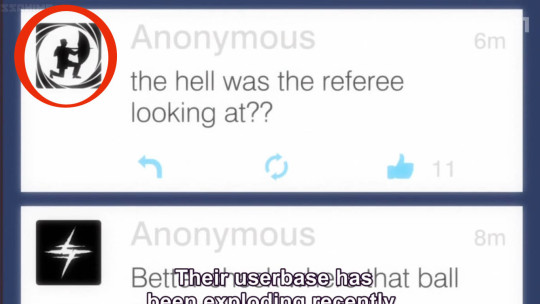

THIS SCENE. THIS SCENE RIGHT HERE. The perfect setup for a villan. I'm forever dissapointed that they gave him a rushed development in episode 25, when he became all of a sudden supportive.And this villan setup didn't receive a satisfying payoff.Insted of developing Paul as a threat to the story, they made him a generic shitty father character.I feel like he could've been an even bigger threat than Croix, given his political power. Speaking of that, it would've been cool to dive deeper into the conflict of magic and politics and how the two affect each other.

And the fact that Andrew and Diana are cousins but Paul obviously doesn't come from a witch family, yet hates magic leaves room for exploring the reason to Paul's hatred for magic, as it feels more personal than political.
AND THE CROIX HANBRIDGE THEORY:
https://softbunny99.tumblr.com/post/659913824428752896
Here are some parallels I found to back up the theory I made a a year and a few months ago:
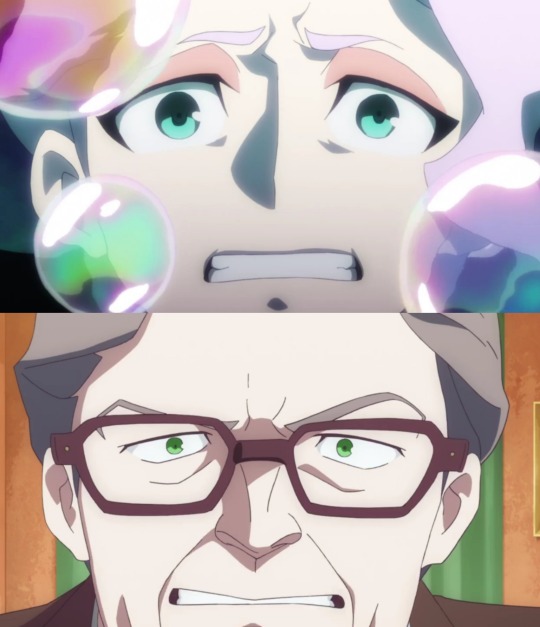


This is one of the reasons I think Little witch academia still has a lot of stories left to tell.
And think I wouldn't have been half as angry about Paul Hanbridge if he still kept this design:
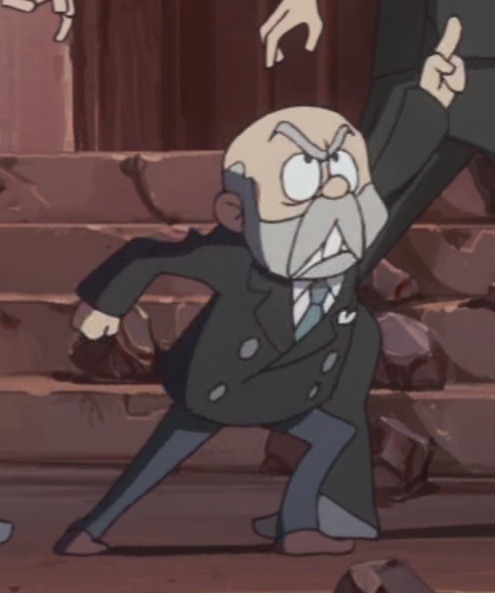
(I have an entire theory to how this character we prototype Paul Hanbridge, but that would make this analysis/rant too long)
#little witch academia kingsman#Little witch academia#Little witch academia analysis#Paul Hanbridge#andrew hanbridge#croix meredis#diana cavendish#akko kagari#sucy manbavaran#lwa#lwa memes#lwa theory
46 notes
·
View notes
Text
PT 2 of "Alastor made a deal with Lwa" aka normal explanation
so the main thing about having a deal with Lwa is that they give a person the powers or whatever they want and in exchange the person gives them their soul and undertakes to supply them with food bc Lwa are hungry for blood
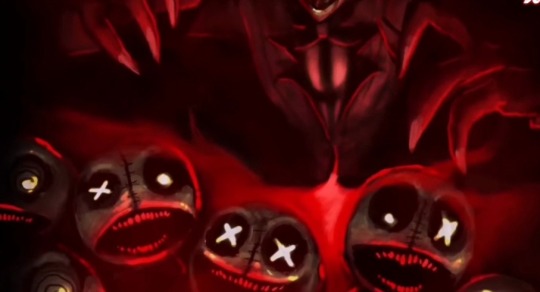

and that's what Alastor does!
he was given the powers and as we know he was a serial killer while alive (half confirmed, but a huge fanon fact) and continued this way in hell
also the deal with Lwa explains why the power shield Al made during the battle for the hotel couldn't be broken by angelic powers-

as we know, demons' power is vulnerable for angels' power and angels can't be hurt by it
according to Vodou religion, Lwa aren't demons - they're Deities
so that's why the exorcists were unable to pierce the shield with angelic weapons - because it was created by divine power essentially equal to theirs
another thing I noticed (not really a proof to anything, just an interesting detail) is that in Alastor's part of Finale he sings about how he wants to break the deal and "unclip" his wings to be free
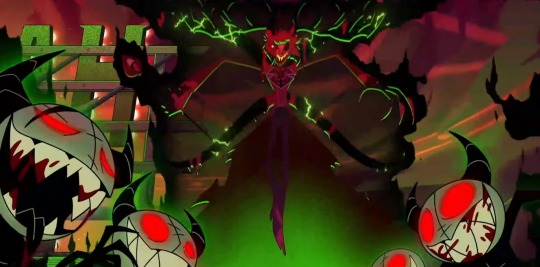

and here we have his tentacles in his demon form situated right where wings are usually are
so here are my thoughts on Alastor's deal
:P
PT1 :
#hazbin hotel#hazbin hotel alastor#hazbin alastor#alastor#alastor hazbin hotel#lwa#vodou#hazbin hotel theory#alastor's deal#hazbin hotel alastor's deal
48 notes
·
View notes
Note
LWA: Regarding the halo: we see a variant in the Job minisode. When Aziraphale does his "avaunt" speech, he has a full-body aureole, which unlike the halo around the head is /not/ an angelic attribute in religious painting and sculpture. The design of Aziraphale's aureole, with golden rays emanating from his body, looks like it was modeled on Marian iconography, as in the case of the Virgin of Guadalupe (https://www.metmuseum.org/art/collection/search/635401). There are a bunch of other examples, like the Madonna of Humility at the Getty Museum, where both the Virgin and God have ray aureoles. I am not sure where the design team thought they were going with this, although it fits with the Madonna pose they used for that promotional photo of Aziraphale in his Job robes.
ahhhhh this is so interesting!!!✨ i had no idea before this that there was such a nuance between aureole and halo, and their individual meanings in iconography (and thats not even taking into account different individual depictions like mandorla etc!). given the - as ive now learnt - very subtle but definite distinction between the two, and their individual meanings in religious contexts, it seems reasonable that the design team might have gone to some lengths to research it similarly!!!
(and now i shall spam you all with research because i am excited and Must Share)
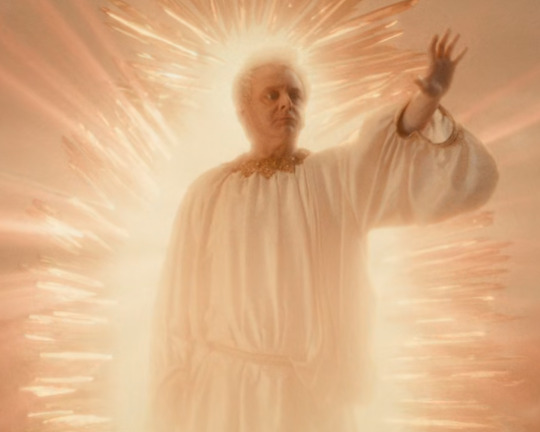

so as LWA, the oracle of all truth, has said - ep2 where aziraphale appears to crawley shows him with an aureole surrounding him, much like the multiple depictions of Our Lady of Guadalupe (above is the Virgin of Guadalupe, by Salcedo, 1779). other depictions/notable copies of the original however include:

(L-R: de Arellano, 1691, Gonzalez, c. 1698, and the original from cy/16th, upon which they're based which, as far as i can find, has no confirmed artist?).
and coming back to italian renaissance (which im slightly more familiar with), the following works show the same:

(L-R: Madonna and Child with Two Saints, Pisanello, c. 1445, The Last Judgement, Michelangelo, f. 1541, and Baptism of Christ, Verrocchio and da Vinci, c. 1475)
it is especially prevalent in christian religious art, but as LWA said it does appear to be mostly used for religious figures, and not necessarily angels or saints (most of those are depicted with halos instead). most examples, like the ones above, that ive found seem to be used exclusively for jesus and mary. in other religions such as buddhism, aureola appear to be shown in the form of a mandorla (an almond-shaped field) that surround enlightened beings, such as Buddha.
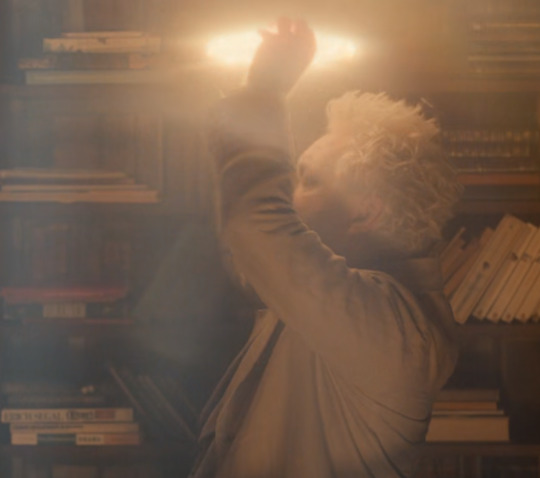

let's move onto halos; ep6 shows our funky angel removing his, and is shown in the form of a ring, emitting the same kind of light as the aureole. disks have been depicted in art from well before the time of christ, including in ancient egypt (ra) and in iran (mithra).
funnily enough, finding depictions of ring halos rather than disk/plate ones was actually quite difficult? either way - above shows Virgin of the Rocks by da Vinci, f. 1486, shows a subtle but clear ring halo over Mary's head. keeping with the cy/15-16th onwards for fair comparison, showing a combination of disk and ring halos:

(L-R: Branchini Madonna, di Paolo, 1427, Madonna of the Book, Botticelli, c. 1481, and Deposition of Christ, Raphael, 1507)
these all again are examples depicting christ and mary, so what about angels? i found the best example to look at is the annunciation to mary, as this was the subject of a number of notable pieces in the same time period:

(L-R: da Vinci, f. 1476, Fra Angelico, 1450, and Botticelli c. 1490)
all show gabriel with a halo around their head, as opposed to an aureole. the one that fascinated me though is botticelli; there is relatively little known about his depictions of the annunciation, but there are multiple - the above is in glasgow, there is another in new york, and the last is the Cestello Annunciation). however, in the first two, glasgow and new york, there is a clear feature of an aureole-type shaft of light coming from behind gabriel, and shining upon mary.
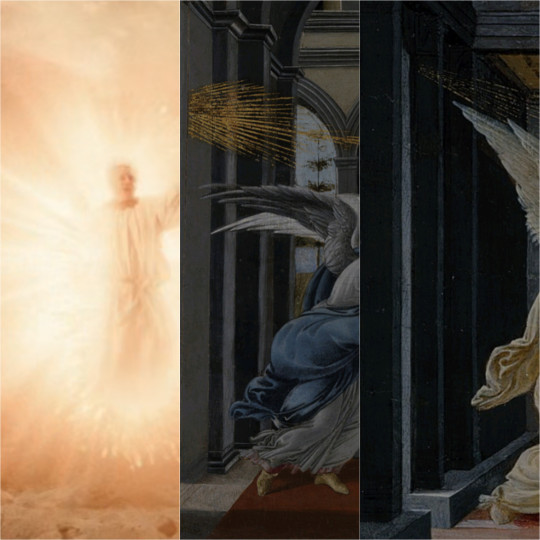
i certainly think that it's mostly representative of god's gift being bestowed on her, ("The Holy Ghost shall come upon thee, and the power of the Highest shall overshadow thee.", Luke 1:35) but the perspective of the glasgow painting almost shows like the light comes from a crack in the wall, and would suggest that aziraphale stepping out from the aureole as some sort of glorified portal is a mirror of this.
anyway, because ive rambled on long enough about nothing truly insightful; what is the point in these two different displays? well, from my research, it seems to be that aureola are used to surround the head or the body, and iconographically represent divinity, glory and, depending on the subject/context, enlightenment.
but given that it has largely been reserved in art for the depictions of the holy trinity as well as mary, to outright use it in connection with aziraphale seems... strange. in this particular scene, or part of his story, why has he been purposefully elevated to the same level of importance and power? we have no reason to suspect from the ensuing dialogue that god sent aziraphale deliberately in her name to thwart crowley, carrying her power... or did she?
the halo however appears to be specifically used for instances of depicting angels or saints (in the case of gabriel and various apostles in multiple artworks), as well as jesus and mary. so that to me would suggest that halos are somewhat specifically meant to represent innate saintliness and holiness, inherent divine nature. were specifically touched by god's grace and love, and were embodiments of god's will.
what this necessarily means in relation to aziraphale though, beyond him obviously being an angel, a representative of the heavenly host, and a messenger of god's will etc... im not entirely sure.
there is presumably no reason for him to be depicted with an aureole unless, as LWA suggests, it's to draw parallels to artwork where mary is especially shown as having one. but in the context of s2 (and the job minisode), isn't this a little out of field?
another thing - aziraphale does seem to be able to turn it on and off like a tap, suggesting that it's there in the narrative for sheer Impressiveness, to Look The Part, in front of a demon... so, is it only for design purposes, because cinematically it's bloody cool to look at? or is it meant to give insight into aziraphale's thoughts and beliefs?
with it, would he (in aziraphale's mind, bless) look intimating enough to thwart crawley's 'nefarious plan' with minimal effort? possibly, but i doubt it; im a pretty firm believer in Reasons for certain design choices, especially ones that would take a lot of post-production work to animate. so, could aziraphale have chosen to appear with the aureole, to be suitably intimidating, but after having his faith in god's will shaken after the events of job, chose not to manifest it again, because its symbolism no longer rings true for him?
#this response was an insane amount of effort#especially whilst melting in 28c heat#good omens#ask#everyone say thank you to LWA for another stellar observation and insight#fun fact: i read 'job robes' as jobes and now they will only ever be jobes to me#jobes (job robes)#halo theory#mary/pieta spec#s2 meta#costume meta
49 notes
·
View notes
Text

Little Witch Academia girls organised by their favourite Big Bang Theory character
#little witch academia#Lwa#Akko#atsuko kagari#sucy manbavaran#Lotte Hanson#big bang theory#leonard hofstadter#Sheldon Cooper#Bazinga#Ello Chinese#Tier list#Akko is my wife and I am her malewife
12 notes
·
View notes
Text
Okay so here's a thought I had: is Alastor's soul belonging to someone else common knowledge? Or does Husk somehow know something others don't?
My gut read says it's not common knowledge, but then how does Husk know? When did it happen? People generally seem to assume two things:
A) He sold his soul to Lilith and
B) it happened during the interim seven years that both he and Lilith were gone.
But here's a pitch: he sold his soul to Lilith IMMEDIATELY after entering Hell.
Canonically, he came out of nowhere with a huge amount of power. That doesn't seem standard for demons; most seem to have to build up their strength over the years.
So here's my theory, in a vague ramble rather than a coherent narrative:
When Alastor died and arrived in Hell, he had little to no power, but a lot of wits and ambition. A lot of gumption and a lot of intention. Somehow, he caught the eye of Lilith.
Maybe he'd done so already in life. There seems to be an implication of his using magic, with a reasonable amount of detail going into the lwa symbols that underscore some of his displays of power. Maybe he'd sold his soul to Lilith before he died, but did so in a way that helped him in death as well.
Lilith takes a very long time to lank on his leash. But when she does, its not a pleasant feeling. Not something he enjoys, feeling lesser or powerless. He tries to blot out that feeling by being a dealmaker himself, but he can't out-deal-make the one who empowers his deals.
Lilith's requirements of him after those seven years grant him a lot of freedom. They're broad orders that are, in many ways, open to his own creativity and interpretation: help Charlie with her hotel, support her, see that she and the ones she seeks to redeem are safe.
He doesn't have to be nice about it, though being charming certainly helps and I think he enjoys being charming. He finds ways to make it worth his while in the short term, and calls in old oaths to make the sting of being there Not Quite of his own volition lessen some: Husk and Nifty, who he also likes in his own fashion but if he has to be here, so do they.
He knows what Lilith wants. Maybe he knows why. Maybe not. But if Angel's leash is smoke and Husk's is iron, his is titanium. The chain is long but the collar is tight; the orders worded like requests and instructions to a respected subordinate but no less impossible to ignore.
But at least its not boring.
28 notes
·
View notes
Text
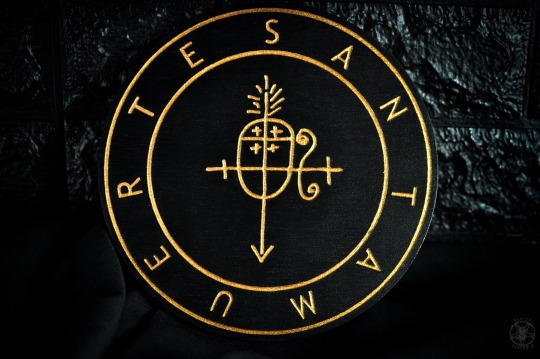

Image ID: First image: a "veve" of La Santa Muerte. Second image The same "veve" but with the "no" sign superimposed. End Image ID
If you involved in El Culto a la Santa Muerte in any sort of way, chances are that you may have seen this "sigil" online and being sold on places like etsy
It is fake and cultural appropriation. Do not use
The "sigil" you see here is supposed to be a veve, a religious symbol used in Haitian Vodou to represent a specific Lwa (at least according to Wikipedia). Santa Muerte is not a Lwa; she is a Mexican Catholic folk saint. She does not have veve
Now while there is a theory that an ATR may have influenced the creation of El Culto a la Santa Muerte, the ATR is question is Santería, not Haitian Vodou. To my knowledge, Santería does not use veves
Further digging into the origins of this fake veve revealed that it was allegedly made up in 2012 by someone attempting to demonize both El Culto and Haitian Vodou
Unfortunately, as El Culto grows in popularity and more and more people ignore pleas and warnings from traditional Mexican Muerteros to not separate Santa Muerte from Mexican culture and Catholicism, this sort of thing will occur more often
It is important that followers and allies, particularly white followers and allies, do their research and prevent this sort of thing from spreading. If you are not Mexican, this includes doing research on Mexican culture and Brujería. This is not permission to appropriate Mexican culture or Brujería. If you are not Catholic, research on Catholicism. I would also recommend doing research on Aztec and Maya Mythology, Santería, and El Culto al San Pascualito Rey as these are all believed to have directly influenced El Culto a la Santa Muerte. Once again, this not permission to appropriate closed practices
Also important is to listen to traditional Mexican Muerteros. Traditional Mexican Muerteros have stated countless times that El Culto a la Santa Muerte cannot be divorced from Mexican culture or Catholicism and should not be combined with other religions (And please do not try to use Indigenous Mexicans syncretizing the veneration of Santa Muerte with the worship of Mictecacihuatl or other Indigenous Mexican goddesses as a counter example. That is not the same thing).
tl;dr: This "veve" is culturally appropriative bullshit and should not be used by followers or devotees of la Santa Muerte
30 notes
·
View notes
Text
What if Alastor is a Vodou Lwa himself?
DISCLAIMER: Everything I'm writing on this post is not to be taken seriously for I'm writing this as a way to see Vivziepop's perspective on Voodoo and how she wants to use it for Alastor. I do not understand the complexity of the Vodou religion and I just made some quick wikipedia searches to pick up pieces that might help me on the theory of what Viv might intend with Alastor and I'd be very glad to hear some clarifications or additions to the accuracy of this theory.
------------------------------------------------------------------------------
I remember Vivziepop stating that Hazbin Hotel is suppose to be a mix of different theologies, not just the christian one, and that Hell and it's demons is not supposed to be all too accuracte about the biblical description. I was curious because Alastor, a demon using voodoo magic, strongly implies that there are many Lwas/Ioas in this setting and likely are all demons, even though in official theology they are supposed to be more like angels, though there are plenty Lwas that range from unpure, to arrogant, to unnecessarily cruel and evil, so I get why Viv would assume them as demonic.
There is this detail on the Haitin Vodou wiki site: "New lwa are nevertheless added to the pantheon, with both talismans and certain humans thought capable of becoming lwa, in the latter case through their strength of personality or power."
There are a ton of Iwas, most of them unnamed, and there can easily be added more by new human concepts embodying as them. I think Alastor might have become an Iwa himself, a particularly major one.
Here is how I think Alastor has become an overlord Iwa: Alastor was a popular radio host, cannibalist, voodoo practitioner, and murderer, he died and came to Hell, and due to him having served the dark forces well Lucifer thinks of making him an Overlord Lwa, there is no Lwa that at the time might have been asociated with radios, if there is one, Alastor likely replaces them or has become the Iwa of radios, and partially other things like voodoo itself, cannibalism, murder, gentelems, etc.
Viv seems to want to make voodoo an entirely demonic force, something that would be an extention of Lucifer himself, which is very inaccurate to how voodoo actually works.
If this ends up being the case, then this implies that other demons outside the hellaverse hierarchy we know of might also be Lwas. I remember in the pilot there being a random demon that could teleport just like that, they have magical powers too, maybe they too are an Lwa? Perhabs.
What do you think? Do you think Alastor might be an in-verse Lwa, that he might be inspired by an already eisting Lwa, that Hell has a lot of Lwas, that Viv should make deeper research about bible and voodoo lore than just seeing a character making dolls that affect other people or Dr. Facilier from Princess Frog? Let me know if I made any misconceptions about Voodoo and if there are details of vodou religion that might add or disprove my points.
21 notes
·
View notes
Text
RE: Was Baron Samedi worshiped in New Orleans prior to the late 20th century?
This one is also about the actual lwa.
Baron Samedi can aptly be described as not just the most iconic lwa, but one of the most iconic things from New Orleans Voodoo. Ironically, I have only found inconclusive evidence that he was worshiped in New Orleans during the 19th or early 20th centuries.
In American popular media, Baron Samedi is frequently conflated with other Haitian deities, called the Gede. The real-life Baron Samedi has his origins in Haitian Vodou, as does Maman Brigitte (Gran Brijit). The Haitian lwa are derived from African deities, among the most important being the Dahomean trickster god Legba (himself, derived from the Yoruba deity Eshu). Over the course of Haitian history, Dahomean Legba was refracted into Papa Legba, Met Kalfou, and the Gede - by extension, the Bawons, including Baron Samedi. This explains why the Gede are trickster deities of sexuality and liminality, who embrace all that is taboo - just like Dahomean Legba!
19th Century New Orleans Voodoo was greatly influenced by Haitian Vodou, due to the massive influx of Haitian refugees that arrived in the Crescent City after the Haitian Revolution. Following the post-Revolution migration wave, several Haitian lwa became features of New Orleans Voodoo, including:
Papa Legba → “Papa Limba” or “La Bas”, syncretized with St. Peter
Damballah → “Daniel Blanc”, syncretized with St. Michael
Agassu → “Yon Sue”, syncretized with St. Anthony
Ogou Feray could have also been worshiped as “Joe Ferraille” (“Joe Feray”), and Ayizan Velekete as “Vériquité”. While the Erzulies were not directly worshiped per se, veneration of Mother Mary was a key feature of 19th century New Orleans Voodoo. (The Erzulies are syncretized with Mother Mary.)
(I should also note that, in New Orleans, the lwa were called “spirits”, while Bon Dieu/Bondye was simply called “God”)
During the 19th century, the two most important lwa were probably Papa Legba - the Doorkeeper - and Damballah - the most ancient of the lwa. This would explain why their names appear most frequently in 19th- and 20th-century sources, especially in large scale rituals. Damballah might have been refracted into multiple deities, including “Daniel Blanc” and “Zombi the Snake God” – a deity famously associated with Marie Laveau. Others argue that “Grand Zombi” is actually derived from the Kongo supreme deity Nzambi Mpungu, or an invention fabricated by journalists.
A third key deity – “Onzancaire” / “Monsieur Assonquer” – might have been associated with Ogou Feray – one of the most important Haitian lwa. However, the origins of “Onzancaire” are elusive. Because so many different theories have been proposed, I do not know where his true origins lie.
Other deities of non-Haitian origin were also features of New Orleans Voodoo. St. Marron (Jean St. Malo) was the New Orleanian folk saint of runaway slaves. Mother Leafy Anderson – founder of the Spiritual Church Movement in New Orleans – introduced worship of the Native American Saint Black Hawk (see: Kodi A. Roberts (2015) Voodoo and Power: The Politics of Religion in New Orleans, 1881–1940). My understanding is that “Dr. John” (Jean Montaigne) was also deified, in a similar manner to St. Black Hawk. Orisha, such as Shango and Oya, may too have been worshiped. Other deities are listed here and here.
Baron Samedi is conspicuously absent. I think this has to do with the history of Haitian Vodou. Prior to the Haitian Revolution, Haitian Vodou was less of an organized religion, described as a "widely-scattered series of local cults" (see: The Social History of Haitian Vodou, p. 134). It was between the years 1804 and 1860 that Haitian Vodou began to stabilize into a clear predecessor of its present form. (see: The Social History of Haitian Vodou, p. 139) This period of stabilization took place after the migration wave of the early 19th century, which could explain why key features of Haitian Vodou are missing from 19th century New Orleans. For example, I have yet to find evidence that division of the Petwo and Rada lwa made it over to American soil. The refraction of Dahomean Legba might have never been transmitted by Haitian refugees, which would explain the absence of Met Kalfou and the Gede/Bawons from worship.
This too explains why the Papa Legba of American history was both Doorkeeper AND Guardian of the Crossroads. It has been theorized that the legendary “Devil at the Crossroads” was actually Met Kalfou. However, this “Devil” does not match the appearance of Kalfou, described as "no ancient, feeble man...huge and straight and vigorous, a man in the prime of his life." Instead, the one at “the Crossroads” appears as a limping old man who loves music and dogs (“Hellhound on my Trail”). It’s Papa Legba!
Rather than Kalfou, I think American Papa Legba actually inherits his more menacing attributes from Eshu. This would explain why he walks with a limp (like Eshu), is notoriously vengeful (like Eshu), and is sometimes described as androgynous (like Eshu!).
In any case, the Papa Legba of American history can be clearly traced back to Haiti. His appearance as a limping old man is inherited from Haitian Papa Legba; his love of dogs and music from Dahomean Legba. 19th century sources clearly identify him with Saint Peter (“St. Peter, St. Peter, open the door;”) The same cannot be said for Baron Samedi. He was probably not syncretized with St. Expedite, because St. Expedite “did not achieve popularity until the late 1800s or early 1900s in New Orleans” – long after the Haitian migration wave.
I have found one compelling source that places worship of Baron Samedi in 19th century New Orleans. Creole author Denise Alvarado is something of an expert on this topic, her being born and raised in New Orleans. In Witch Queens, Voodoo Spirits, and Hoodoo Saints: A Guide to Magical New Orleans (2022), Denise Alvarado identifies a “Spirit of Death” with Baron Samedi / Papa Gede. The most convincing piece of evidence comes from the second interview, in which the interviewee describes a ceremony where attendees donned purple robes. The color purple has been historically associated with Papa Gede (by extension, Baron Samedi).
That being said, I do think the evidence Alvarado provides is tenuous. Without additional context, it’s difficult to say whether the purple robes are truly linked to the Haitian lwa. The other newspaper article sounds rather sensationalized. The 19th century saw horrendous news coverage of New Orleans Voodoo, where reporters would exaggerate or straight-up fabricate details to demonize Vodouisants. The reporter’s description of the spirits of death does not align with the Haitian Gede or Bawons. It is important to remember that New Orleans Voodoo is not entirely Haitian in origin. Several other traditional African spiritualities are woven into New Orleans Voodoo. Prior to the Haitian migration wave of the early 19th century, one of the main influences was Kongo spirituality, in which ancestor veneration is central. Additionally, the newspaper cited is from the year 1890 – years after Marie Laveau’s death. The reliability of this article is therefore questionable. I think this could be a Damballah / “Grand Zombi” situation, where this “Spirit of Death” bears superficial resemblance to the lwa but isn’t actually him. It is also possible that he is simply a fabrication by journalists.
The defamation of Vodou continued into the early 20th century, as Haiti was occupied by the U.S. between the years 1915 and 1934. I don’t see how worship of the Gede/Bawons could have been transmitted to New Orleans between the end of the Haitian migration wave and year 1934. There’s a good chance that Baron Samedi / Papa Gede only properly became features of New Orleans Vodou during the revitalization movement of the late 20th century.
As such, I propose two hypotheses:
Baron Samedi was not properly worshiped in New Orleans until the late 20th century. He quickly rose in popularity, as he was easily grafted onto the pre-existing worship of the spirits of the dead (ancestors).
Alvarado has correctly identified Baron Samedi / Papa Gede with the “Spirit of Death”; however, this “Spirit of Death” was a radical departure from his Haitian predecessor, taking on a markedly different form from the lwa.
But that’s all just a Theory… A GAME THEORY!!!
…Anyways, annotated bib:
Marshall, Emily Zobel. American Trickster: Trauma, Tradition and Brer Rabbit. Rowman & Littlefield, 2019.
Chapter 1 ("African Trickster in the Americas") describes Dahomean Legba’s origins in the Yoruba deity Eshu.
Cosentino, Donald. "Who is that fellow in the many-colored cap? Transformations of Eshu in old and new world mythologies." Journal of American Folklore (1987): 261-275. https://www.jstor.org/stable/540323.
From the abstract: “Myths of Eshu Elegba, the trickster deity of the Yoruba of Nigeria, have been borrowed by the Fon of Dahomey and later transported to Haiti, where they were personified by the Vodoun in the loa Papa Legba. In turn, this loa was refracted into the corollary figures of Carrefour and Ghede.” Accessed here: https://www.centroafrobogota.com/attachments/article/24/17106647-Ellegua-Eshu-New-World-Old-World.pdf
Haitian immigration : Eighteenth and Nineteenth Centuries. The African American Migration Experience. https://www.inmotionaame.org/print.cfm@migration=5.htm
Describes post-Haitian Revolution migration wave like so: “the number of immigrants [from Haiti to New Orleans] skyrocketed between May 1809 and June 1810… The 1809 migration brought 2,731 whites, 3,102 free persons of African descent, and 3,226 enslaved refugees to the city, doubling its population.”
Fandrich, Ina J. “Yorùbá Influences on Haitian Vodou and New Orleans Voodoo.” Journal of Black Studies, vol. 37, no. 5, 2007, pp. 775–91. JSTOR, http://www.jstor.org/stable/40034365. Accessed 23 June 2024.
Mentions worship of Ogou Feray as “Joe Ferraille”. Fandirch herself cites Long, C. M. (2001). Spiritual merchants. Knoxville: University of Tennessee Press, p. 56: https://archive.org/details/spiritualmerchan0000long/page/56/mode/2up?
Long, Carolyn Morrow. A New Orleans voudou priestess: The legend and reality of Marie Laveau. University Press of Florida, 2007, p. 247: https://books.google.com/books?id=_XzSEAAAQBAJ&pg=PT247#v=onepage&q&f=false
Mentions worship of Ayizan Velekete as (the male) “Vériquité”.
Anderson, Jeffrey E. Hoodoo, voodoo, and conjure: A handbook. Bloomsbury Publishing USA, 2008, p. 15: https://books.google.com/books?id=TH7DEAAAQBAJ&pg=PA15&lpg=PA15#v=onepage&q&f=false
Relevant quote: "Blanc Dani, Papa Lébat, and Assonquer make the most frequent appearances in both nineteenth- and twentieth-century sources. The first two, in particular, figure prominently in large-scale rituals."
Humpálová, Denisa. "Voodoo in Louisiana." (2012). https://dspace5.zcu.cz/bitstream/11025/5338/1/BP%20Denisa%20Humpalova%202012.pdf
One of several sources that identifies “Grand Zombi” with Nzambi Mpungu.
Long, Carolyn Morrow. A New Orleans voudou priestess: The legend and reality of Marie Laveau. University Press of Florida, 2007, p. 247: https://books.google.com/books?id=_XzSEAAAQBAJ&pg=PT247#v=onepage&q&f=false
Posits that “Grand Zombi” could be derived from Nzambi Mpungu, or "may be the invention of journalists inspired by "zombie tales" of Haiti's infamous living dead, combined with Moreau de Saint-Méry’s endlessly repeated description of a snake-worshiping ceremony in colonial Saint Domingue."
Anderson, Jeffrey E. Voodoo: An African American Religion. LSU Press, 2024, p. 46: https://www.google.com/books/edition/Voodoo/O-v3EAAAQBAJ?hl=en&gbpv=1&dq=%22assonquer%22+%22azewe%22+vodou&pg=PA46&printsec=frontcover
Describes several possible origins for the elusive “Onzancaire”, including a theory that he was a deity related to Ogou Feray.
Long, Carolyn Morrow. A New Orleans voudou priestess: The legend and reality of Marie Laveau. University Press of Florida, 2007, p. 236: https://books.google.com/books?id=_XzSEAAAQBAJ&pg=PT236#v=onepage&q&f=false
One of several sources to describe St. Marron (Jean St. Malo).
Roberts, Kodi A. Voodoo and Power: The Politics of Religion in New Orleans, 1881-1940. LSU Press, 2015, p. 82: https://books.google.com/books?id=EWOkCgAAQBAJ&pg=PT82&lpg=PT82
Describes how Mother Leafy Anderson (founder of the Spiritual Church Movement) “found” St. Black Hawk, introducing him to New Orleans Voodoo.
Alvarado, Denise. Witch Queens, Voodoo Spirits, and Hoodoo Saints: A Guide to Magical New Orleans. Weiser Books, 2022, p. 39: https://books.google.com/books?id=ktlWEAAAQBAJ&pg=PA39&lpg=PA39#v=onepage&q&f=false
Posits that high priestess Betsy Toledano worshiped the Orisha Shango and Oya during the 19th century.
Anderson, Jeffrey E. Hoodoo, voodoo, and conjure: A handbook. Bloomsbury Publishing USA, 2008, p. 15: https://books.google.com/books?id=TH7DEAAAQBAJ&pg=PA15&lpg=PA15#v=onepage&q&f=false
List of deities worshiped in 19th century New Orleans Voodoo.
Alvarado, Denise. Witch Queens, Voodoo Spirits, and Hoodoo Saints: A Guide to Magical New Orleans. Weiser Books, 2022, p. 126: https://www.google.com/books/edition/Witch_Queens_Voodoo_Spirits_and_Hoodoo_S/ktlWEAAAQBAJ?hl=en&gbpv=1&pg=PA126
Another list of deities worshiped in 19th century New Orleans Voodoo.
Mintz, Sidney & Trouillot, Michel-Rolph (1995) “The social history of Haitian Vodou” in Cosentino, Donald J., ed., Sacred Arts of Vodou, Chapter 4. LA: UCLA Fowler Museum, 123-47. P. 134: https://ghettobiennale.org/files/Trouillot_Mintz_LOW.pdf
Describes Haitian Vodou as a "widely-scattered series of local cults" prior to the Haitian Revolution.
Mintz, Sidney & Trouillot, Michel-Rolph (1995) “The social history of Haitian Vodou” in Cosentino, Donald J., ed., Sacred Arts of Vodou, Chapter 4. LA: UCLA Fowler Museum, 123-47. P. 139: https://ghettobiennale.org/files/Trouillot_Mintz_LOW.pdf
Describes the stabilization of Haitian Vodou into a predecessor of its current form. This occurred between the years following the Haitian Revolution and year 1860.
Deren, Maya. Divine Horsemen : The Living Gods of Haiti. New Paltz, NY: McPherson, 1983 (originally published in 1953), p. 101: https://archive.org/details/divinehorsemenli00dere/page/100/mode/2up
Description of Kalfou (Carrefour) as "no ancient, feeble man...huge and straight and vigorous, a man in the prime of his life." Deren conducted her ethnographic work during the 1940s and 1950s.
Marvin, Thomas F. “Children of Legba: Musicians at the Crossroads in Ralph Ellison’s Invisible Man.” American Literature, vol. 68, no. 3, 1996, pp. 587–608. JSTOR, https://doi.org/10.2307/2928245. Accessed 23 June 2024.
Description of “The Devil at the Crossroads” as a musical genius and “limping old black man”: “Most versions of this story instruct the aspiring musician to bring his instrument to a lonely crossroads at midnight and await the arrival of a limping old black man who will tune the instrument, play it briefly, and then return it endowed with supernatural power."
Robert Johnson’s song “Hellhound on My Trail” identifies “The Devil at the Crossroads” with Papa Legba, who is associated with dogs.
Long, Carolyn Morrow. A New Orleans voudou priestess: The legend and reality of Marie Laveau. University Press of Florida, 2007, p. 244: https://books.google.com/books?id=_XzSEAAAQBAJ&pg=PT244&lpg=PT244#v=onepage&q&f=false
Relevant quote: "Mary Washington, born in 1863, said she was trained in the arts of Voudou by Marie Laveau. She remembered a song that was sung at the weekly ceremonies: "St. Peter, St. Peter open the door; I am callin' you, come to me; St. Peter, St. Peter open the door." Mrs. Washington explained that "St. Peter was called La Bas, St. Michael was Daniel Blanc, and Yon Sue was St. Anthony." She also mentioned a spirit called Onzancaire."
Alvarado, Denise. The Magic of Marie Laveau: Embracing the Spiritual Legacy of the Voodoo Queen of New Orleans. Weiser Books, 2020, p. 57: https://books.google.com/books?id=SZOMDwAAQBAJ&pg=PA57&lpg=PA57#v=onepage&q&f=false
Relevant quote: “Baron Samedi remains a popular and powerful force in New Orleans Voudou today, along with his wife Manman Brigit. He is syncretized with St. Expedite, among the most popular of saints in New Orleans. We do not hear of St. Expedite in association with Marie Laveau, however, because he did not achieve popularity until the late 1800s or early 1900s in New Orleans (Alvarado 2014).”
Alvarado, Denise. Witch Queens, Voodoo Spirits, and Hoodoo Saints: A Guide to Magical New Orleans. Weiser Books, 2022, pp. 127-128: https://books.google.com/books?id=GsofEAAAQBAJ&pg=PA127&lpg=PA127#v=onepage&q&f=false
This is the strongest evidence I could find that Baron Samedi / Papa Gede was worshiped in 19th - early 20th Century New Orleans.
Deren, Maya. Divine Horsemen : The Living Gods of Haiti. New Paltz, NY: McPherson, 1983 (originally published in 1953), p. 107: https://archive.org/details/dli.ernet.505921/page/107/mode/2up?q=purple
Historical evidence that, since at least the 1940s, Papa Gede’s colors are “black or purple”. To this day, purple is associated with Baron Samedi and the Gede as a whole.
Long, Carolyn Morrow. A New Orleans voudou priestess: The legend and reality of Marie Laveau. University Press of Florida, 2007, p. 250: https://books.google.com/books?id=_XzSEAAAQBAJ&pg=PT250&lpg=PT250
Relevant quote: “The religion that evolved in nineteenth-century New Orleans and was embraced by Marie Laveau and her Voudou society combined traditions introduced by the first Senegambian, Fon, Yoruba, and Kongo slaves with Haitian Vodou, European magic, and folk Catholicism. It also absorbed the beliefs of blacks imported from Maryland, Virginia, and the Carolinas during the slave trade of the 1830s–1850s. These “American Negroes” were English-speaking, at least nominally Protestant, and practiced a heavily Kongo-influenced kind of hoodoo, conjure, or rootwork. New Orleans Voudou is therefore not identical to Haitian Vodou, but represents a unique North American blend of African and European religious and magical Traditions.”
Fandrich, Ina J. “Yorùbá Influences on Haitian Vodou and New Orleans Voodoo.” Journal of Black Studies, vol. 37, no. 5, 2007, pp. 775–91. JSTOR, http://www.jstor.org/stable/40034365. Accessed 23 June 2024.
Describes major Senegambian and Kongo influences on New Orleans Voodoo, prior to the Haitian Revolution. Relevant quote: “New Orleans's African population was Kongo dominated with a strong affinity with the spirits of the dead…Dahomeyan influence occurred only indirectly through the Haitian refugees who "flooded" the city after 1808. In 1809 alone, more than 10,000 Haitians arrived, and doubled the city's population. They brought their Vodou religion with them, which ultimately merged with the already existing New Orleans or Louisiana Voodoo traditions. During the French colonial regime, 80% of the enslaved Africans came from one single ethnic group: the Bamana (also called Bambara) people from the Senegal River basin (today's Senegal, Gambia, and Mali), most of them stemming from one single ethnic group, the Bambara people. The majority of the remaining 20% were Kongolese and some Dahomeyans (Hall, 1992). Despite their rather different geographical origins, these two cultures blend easily into one another. Eighteenth-century Louisiana Voodoo maintained a marked Senegambian flavor, with some Kongolese elements blended in, until the end of the 18th century.”
Dubois, Laurent. “Vodou and History.” Comparative Studies in Society and History, vol. 43, no. 1, 2001, pp. 92–100. JSTOR, http://www.jstor.org/stable/2696623. Accessed 23 June 2024.
An overview of the history of Haitian Vodou, as it pertains to U.S. history. Demonization of Vodou continued past the U.S. occupation of Haiti, until the late 20th century.
#between the two it is 100% papa legba who had a bigger impact on horror stories from the american south of the early 20th century#i think a lot of people would think it's baron samedi but no! it's the mischevious limping old man!#commentary#the loa (hazbin hotel)#baron samedi (hazbin hotel)#big papa legba
9 notes
·
View notes
Note
This promo schedule is something that I missed during Layover. The entire timeline is abuzz with the concept photos and teaser. So many hilarious memes, crazy theories...I AM ABSOLUTELY LOVING IT! The anticipation is HIGH and so much fan engagement.
Everyone is loving the vocals and the sound snippets. To me sounds like a hit! Did you enjoy the teasers?
I missed the feeling of a new project by Taehyung, even thought LWA was recent, but it’s different when it’s a project BY Taehyung. New music by him. Concepts. Just amazing.
I enjoyed the teasers a lot! I wonder why they used the same eating clip twice, but maybe the MV will exaplain it to me :)
11 notes
·
View notes
Note
Howdy! First I just wanna say you're a really great artist, one of the best I've ever seen, and I love every single one of your LWA fanarts! And if you don't mind, I just wanted to ask how you learned to draw? I've always wanted to learn, but I'm not sure how to learn the fundamentals and progressively get better until I'm as great as someone like you. If you know any books, videos online, exercises/habits, or any resource to look up and learn how to draw and slowly get better, that'd be great!
Hi! Thank you very much, I’m touched by your kind words ^^
I give you Diakko but theyre motivation coaches to wish you the best ! Have fun with drawing, it's one of the best thing on Earth!

It took some time to answer because I wanted to write a document with a lot of resources, so you and other fellows can use it :
To answer the first part of the question, I always loved doodling with a pencil and replicating manga panels like Dragon Ball, Naruto... also I love scientific illustration and fashion design! Never took art classes, but went to an art club in high school^^
I have a pencil and watercolour self taught art background, drew since 9 but with a lot of art breaks (the most recent one lasted 4 years because of pharmacy studies), digital art came very late when I hit 23 (January of this year, got an iPad!🥳🎂) and I learned it with the resources stated in this shared document :D
Now for the second part, let's say every artist have their own art planet, like the Little Prince 😊
You have your art home, and realism is the house foundation to you build up other skills on it. The first skill associatied with foundation is observation : when you look at something...how does it work? Why is this moving like that? What are the simplified shapes of it?
Near you home, you can plant your favourite artists seeds from other art planets in your own art garden to be inspired by them. They'll bloom into different flowers, scents and colors... they'll inspire your work as you progress :D it's like pretty things to admire and look up to! To keep you on the go and learn from them! (It works with the library metaphor too, like having a collection of your fav artists, subjects, reference...)
Then you build up solid walls for your house, by learning/practicing technical things like figure drawing, life drawing, drapery... with these, you can already have a lot of fun!
Adding windows will bring you some fresh air as you'll explore colour theory, light and shadow... at this stage, traditionally or digitally, you'll be able to create really cool sketches/llustrations! You can always use references and observe them to understand the light source, a particular scenery, or some tricky anatomy position, etc...so you can incorporate it in your drawing.
Then you can make your house bigger by adding new rooms: learning how to draw specific things like detailed backrounds, animals, weapons, machinery, everything you'll be interested in...if you started with humans only for example.
Later on, you can decor your house with things like art style, aesthetics, that little somtheing that makes people recognize your works...these come naturally as you progress so dont worry too much about it!
Building a comfy house takes time but it's your home and even if there will be struggles/frustration... enjoying the process is key to a happy artist journey ^^
Hope this helped, and you can always dm for more specific things, if needed (or ask anonymously again, I’m shy so I’ll understand lol)
27 notes
·
View notes
Text

Hi everyone, I'm back with witches in angry mode~! Yeah in case you didn't know, I have a headcanon that witches become big, scary, and monstrous when angry, based on some stuff from official media. This time of Shao-Yi, a background witch that isn't as well known as Sarah, but still has a lot of fans. Me included!
So for Shao-Yi, I wanted something to compliment her simple yet wonderful design. So I decided to make it seem mystique yet simple. And what's more simple than a giant shadow monster just waiting to drag you into the darkness? I also wanted to make it look intimidating, so I hope this succeeded!
Also, I like to imagine that Shao-Yi is a very nice and patient person, so you have to actively be trying to piss her off!

Or be Amanda and steal her personal family treasures! Which is why she's so furious by the way! But, that's what happens when you steal someone's personal belongings that have such sentimental value to them. So now, Amanda has two choices. Give Shao-Yi her stuff back, or run away and prey Shao-Yi doesn't grab her or catch up. And as you can see, she chose life!
(Also, sorry about how weird Amanda looks and for how sloppy my hand writing is!)
#little witch academia#lwa#shao-yi#shao-yi lwa#amanda o'neill#amanda#theory#lwa theory#angry witch#angry witches
3 notes
·
View notes
Text
So I finished rewatching Lwa episode 6(this one is going to be quite the rant, just a heads up):
The episode that introduces Andrew. The one overhated character in the entire show. I have always thought he's an interesting character with a lot of untapped potential. It's cool to have a character to show the non magical side of the Lwa world. I'm a huge fan of his friendship with Akko and how it develops over time and helps him change into a better person. Friendships between calculated guys and chaotic girls are always fun.

He's one of the reasons I wish Lwa had another season, there is so much to explore with his character and I have so many theories on where his story could go.I have so many positive things to say about his character, even if he didn't have much time to shine, he's still so well written.
HIS FATHER on the other hand...(I don't even know if I should get on with that rant, but at the same time, maybe I should)
#Little witch academia#little witch academia meme#Little witch academia Andrew#andrew hanbridge#little witch academia akko#akko kagari#lwa theory#lwa rant#anime analysis
26 notes
·
View notes
Text
I been obsessed with the space channel “kosmo” since yesterday and this thought came up and it actually annoy me.
(WARNING ATP this turned into more of random ramble but yea)
I feel like using celestial bodies in arts is very underutilized, esp since it could make the art much more profound and emotional. Basically I am saying, gundam fans, please start drawing suletta on mercury or smth like that. Or Use Pluto to symbolize the loneliness of Hitori from Bocchi the rock idk!, I just want more people to actually make supernatural space arts(like signalis or that art with the angel on the moon) I guess
For me, there is just smth euphoric(i think that the word not sure) about space arts and stuff like that for my whole life. It is actually why I got SUPER into Destiny all the way until the dlc after forsaken(i only stop cus I hate the grinding and the money stuff, and felt that the story don’t mesh well with the gameplay, anyway). Smth about the art direction and design just make me go emotionally glow ya know? Like the intro of the first destiny was GOD TIER when they show the Traveller fucking the mars atmosphere or when they show the vex realms thing. I think it actually go beyond space but to series like STALKER or otherside picnic. IDK the hell I am saying but I think basically, Scifi + supernatural + fantasy + space(don’t need all at the same time)= me brain happy.
Weirdly enough it doesn’t include Lovecraft stuff, those bored me for some reasons. Might be cus of how Lovecraft world work is honestly kinda dumb. Like the whole people go insane cus they can’t understand the eldritch is dumb esp cus recently we had found smth that pretty much put big hole in our theory of the space age but we hasn’t go mad so yea. Same with starwar, it kinda stale for me but i still do like the force and Jedi stuff. Funny enough I like the anime shorts they did the most.
I think the whole connection with stars and moon in LWA is partially why I love LWA so much. This whole thing might also be why Manifold garden is one of my most favorite puzzle game ever.
#diakumo#this the easily the most unhinged post I ever made#i don’t even know how to edit it to make sense#i don’t even know what the heck I am saying anymore#but yea I think I may has discover a huge part of myself lol#gundam witch from mercury#bocchi the rock#little witch academia#the scar on the moon make me brr really
11 notes
·
View notes
Note
LWA: Just some random stuff on a Sunday morning!
Missing scenes: Furfur's book of angels includes "bishop" as one of Aziraphale's jobs, and as we've already seen all the others on the list, even if only in deleted lines (the music tutor was originally in the Rome scene), I would guess we'd see that one as well. Not necessarily a good fit for 1650, though, although since Gaiman has done things like have the Bastille still standing in 1793, anything's possible.
Assumptions about character progression: I think there's a tendency to assume that Crowley and Aziraphale develop or ought to develop towards something "better" as the series progresses, but that's not quite right. They become more /complicated/, which is a neutral--dare I say grey?--concept. The novel and series both deny that good and evil are steady-state aspects of character: you /aren't/ good or evil (or something in-between), you /do/ good or evil (or something in-between). S1 Crowley, as both Gaiman and Tennant have said, has no real character arc, but one of the reasons I think the fandom needs to pay attention to my favorite bugbear, the child murder manipulation subplot, is that it is also about moral complexity. Flood-era Crowley offers the moral absolute "you can't kill kids." Armageddon-era Crowley runs Aziraphale over with a trolley problem in order to duck the more unpleasant reality that if you're fine with someone killing a kid for you, you're fine with killing kids. (I have to say that the sentimental "Crowley wuvs Warlock" headcanon is one of those instances where supposedly-positive fanon constitutes outright character assassination, right up there with "Aziraphale had an affair with Oscar Wilde" [oh, do /not/ get me started on why that's horrifying].) The series is on the side of Flood-era Crowley and Madame Tracy, not the "developed" Crowley. Meanwhile, Aziraphale learns how to lie, which is a skill that can be put to different moral purposes in different contexts. Sometimes it's unambiguously good, like saving Job's children; sometimes it's ambiguous-to-evil, like concealing the Antichrist's whereabouts from Crowley (revealing this knowledge to Crowley would mean more pressure to murder the child, but his rehearsed speech suggests that he's willing to let Heaven handle it, perhaps, which is not a viable moral alternative).
AWCW and being "impressionable": one of the funniest things about Crowley is that in some respects, he's every bit as conformist as Aziraphale is, and sometimes more so. His unreliable narration about the Fall hints very strongly that, as you say, he just went along with the "cool kids"--which, despite his protestations to the contrary, /is/ a moral failure on the terms set out by the novel and series. Even later, both Crowley and Aziraphale rebel in ways that maintain the fiction of the overarching system (the Arrangement) rather than dismantling it entirely. Crowley also enjoys his job, especially in the novel. Which, to be clear, is also a moral failure: slacking off is, hilariously, the most moral choice he and Aziraphale can make. FWIW, for me, neither the novel nor the series are "burn it all down" narratives, in part because they both advance a theory of humanity that suggests burning it all down just gets you the same thing from a different direction. The most radical political ideas are given to a conspiracy theorist and to children, and the Antichrist concludes by rejecting all of them and hitting a literal reset button. Pratchett may have co-written the book from a place of "anger," but anger can lead to a lot of different political practices. Obviously, YMMV.
LWA✨ woke up today and chose analytical violence, what a legend
1. see, i feel like 1650 could work for aziraphale's bishop occupation, even if only mentioned retrospectively. theoretically, he could well have been a bishop before the abolishment in 1646, and exploring the episcopalian polity vs presbyterianism argument of the time could be really interesting narratively (especially if handled somewhat like the resurrectionist episode)... but detail aside, even if by the time we see him in 1650 it's only mentioned casually that he was a bishop "a few years back", i don't think it would be entirely out of field. we don't necessarily need to have everything played out on screen!
2. okay, a lot to unpack here, but essentially i agree. the issue it seems to me is to posit moral absolutes in the first place; there will almost always be a contextual 'except'/'but' clause that comes along with it that turns it on its head.
it's bad to kill children, except when they are the antichrist and could bring about the apocalypse.
it's bad to lie, except when it would prevent unimaginable cruelty and grief being wrought on those that don't objectively deserve it.
it's bad to manipulate and brainwash a group of people, except when there's no lasting harm done, and you were only trying to demonstrate to someone that you love them.
it's good to try to further human medicine and prevent needless suffering, except when doing so puts the desperate as the first to fall in the figurative battlefield.
it's good to forgive a huge debt when you don't have any necessity of it being paid, except when it's primarily borne out of materialistic selfishness.
neither character does anything so completely reprehensible, or alternatively so inarguably irreproachable, that someone, somewhere, can't or won't argue a justification for their actions. we individually, according to our own moral compasses borne of our experiences, may justify or condemn what they've done in the narrative - objectively, the morality behind their actions as we've seen them so far is never absolute.
eg. for me, crowley's plan on killing the antichrist, a child, in the specific context of GO is not the condemnable action here; its the manipulation of getting aziraphale to do it because he, personally, will not do it himself. i understand why, but the thing that i personally consider to be unambiguously bad is not killing the antichrist itself, but instead the fact that crowley considers that the only solution to the hellhound being named - ignoring the 'running away' that crops up later, for a moment - is to underhandedly manipulate someone he cares about into doing it instead of him. however, others may see it differently.
who is to say what is 'better', anyway? what even is 'better'? is 'better' to do things only when it's for the benefit of other people? is doing 'better' for your own self not also worthy of consideration? is 'better' wholly only when doing something that is kind or generous to others, rather than being kind or generous to yourself?
whilst crowley hits certain moral epiphanal milestones before aziraphale does, neither have the full right of it - aziraphale should not hold morality to being plainly black or white, dictated to by a set of absolutes that are so basic and lacking in complexity that they are by all accounts redundant. and crowley should not dismiss alternative choices or solutions just because they do not fit his perspective or reasoning, nor hold that his understanding of morality is the only viable one or is the only one with any weight or validity. ep6 imo succinctly demonstrated this.
both of them are still so young at the flood. aziraphale holds that whatever has been decreed by the source 'of all that is good' must therefore be good (and choosing to not see beyond it) and crowley acts so incredulous that something he sees as being absolutely bad would ever be entertained (despite, you know, having been cast out of heaven for 'just asking questions'....). both of them by the time of job have had a pretty seismic shift in that respective naivety - aziraphale begins to question what god actually intends, and crowley acts stoutly bitter and unsurprised by the assignment. neither reactions are compatible still, they constantly circle each other, and literally indicate that some level of understanding (of god, of her will, of morality 'in the real world' itself - take your pick) is still lacking.
re: Oscar Wilde and warlock hcs (i couldn't let these stroll by without comment)... god, where to start. re: warlock, i never begrudge any hc where it's borne out of a developed fanon background. that's arguably one of the main benefits of having the fanon side of things: to develop a point/event/gap in the story for yours and others' amusement - that's cool! for this example, any fic that gives more insight into their years in warlock's life, and therefore gives legitimacy to crowley having a fondness for warlock - yep, i like that! that's awesome, i could see it as an unrealised narrative, but that's where it firmly stays, for me - in fanon.
but i do get frustrated when certain narrative points are pointedly ignored in order to establish a character trait that would otherwise not exist. crowley in canon does not - to me - demonstrate any fondness towards warlock. he literally proposes the option of his murder! i don't think him refusing to entertain killing warlock himself indicates any sentimentality towards the kid - thats a bit of a stretch, imo - but instead it reflects on his character being, put reductively, a bit of a knob sometimes.
as for aziraphale and oscar wilde... yeeaaah. i think anyone that holds that hc seriously needs to reevaluate the implications of it, and whether or not beyond professional (?) respect for his work aziraphale would willingly want to associate with him... ultimately, i refer back to my above point about "...anything so completely reprehensible...". and, respectfully, perhaps there needs to be a little more separation between michael sheen's filmography and aziraphale's narrative - whether in hc or canon.
3. right, AWCW time. i agree re: his conformity to the 'cool kid group' being something that is deserving of scrutiny on his own morality, but i feel like this only is viable once that association goes beyond a certain point (and an arguably arbitrary one at that). essentially, i think it's possible to still see AWCW's decision to associate with the group as understandable and empathetic. we know from the narrative that a) AWCW starts hanging out with them at some point, and b) that lucifer et al. are in the end considered bad people. but were they actually bad at the time that AWCW comes across them? if they were, did AWCW himself know? we don't really have enough narrative to reliably confirm this.
but we do know that AWCW fell, and it's therefore rather likely that he continued associating with them past a point where he would have known that they were Bad News Bears. in the beginning, he may have just been glad that these people seemed to listen to him and make him feel valid for having questions - that's understandable. but as time goes on, as lucifer etc. hypothetically get more and more questionable in their actions and beliefs, AWCW presumably choosing to stick with them, possibly even defending them, confers the deserving of negative judgement onto AWCW in turn (presuming there's no element of coercion or blackmail involved, mind you).
i like the point you raise of aziraphale and crowley respectively not conforming to their inherent purposes (being an angel or demon respectively) when it benefits them personally, being an almost accidental 'good thing', especially when the story puts forward that, however you look at it (ie. whether bc they are lazy, or it poses more excuses to see each other - immaterial), the arrangement is entirely self-serving. 10/10 narrative irony. but this is kinda going back to one of our first asks, LWA - it is for me once again the key difference between rebellion, and revolution:
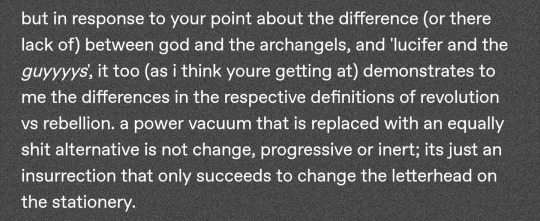
(never been more grateful for making the LWA masterpost, thank you past-me)
so whilst i agree to a certain point that the 'burn it all down' narrative may not be a viable option, or is at the very least a reductive one, i think that the question is what it is replaced with, if at all. adam hit the reset button and put earth back to how it was, because what humanity and earth was - by my interpretation - was just fine as it is. it's not perfect, but not worthy of being destroyed in totality.
so what can we say about heaven? is it a mirror to earth in this respect? i don't think it is. heaven may well have been intended originally as a neutral party with the best of intentions, and then pigeonholed into being the 'good side' following the fall, but it has been allowed to fester and corrupt. maybe we will see more in s3 that there are other angels that feel that heaven as a system is flawed (personally, i think we see this in saraqael's introduction to GO, but that's just my interpretation of the character so far), and maybe those angels will represent the part of heaven that is still redeemable.
so okay, yeah, maybe heaven shouldn't be completely gutted and dismantled, but it is not in the same place as earth is at the time of adam's reset. earth and humanity were arguably the innocent parties in their prospective destruction, whereas heaven has sown their own seeds for it. i don't think the two are entirely comparable. heaven does need a major realignment, and i personally don't think this can happen without some form of systematic reform, without revolution (especially if the wider fandom's evaluation of metatron is true come s3!). it needs reworking with an alternative system that works to be fairer, and removes any binary rhetoric of good vs. evil. don't ask me for the minutae of how this should happen, because i have zero idea (well, very little, anyhow), im not that clever.
but this is what i hope aziraphale will actually be successful in come s3. he can't just - in anger at the injustice of it all - set heaven on fire and walk away from the ashes; it will invite for the original regime to rebuild or something worse to take its place. that being said, it's not just him that needs to do it - to build an alternative to heaven in his own image is equally questionable. again, this is the suggestion that i liked in the armageddon 2.0 meeting in ep6; the idea of democracy in heaven, even if the current board is less than ideal (and the point could poetically hark back to the hypothetical 1650 flashback...?).
#“just random stuff” no you came for the throat LWA own it#i had written like another 4 paragraphs on the anger thing but it got personal really fast so i opted to delete it#youre welcome for being spared from it#once again never sure if ive ever made an Actual Point in my LWA responses but make of it what you will#good omens#ask#the fall/the great war spec#AWCW spec#heaven theory#s3 narrative spec#crowley meta#aziraphale meta
34 notes
·
View notes
Text
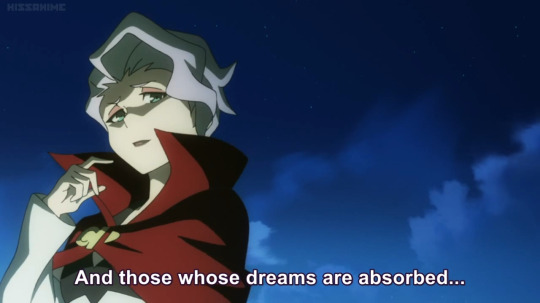

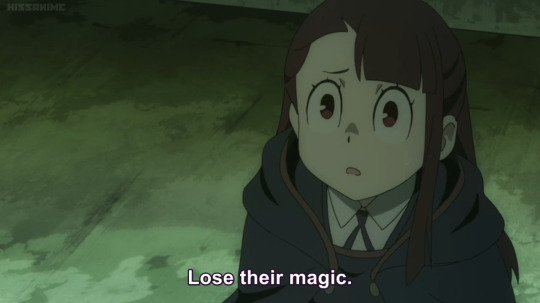

My theory

#little witch academia#lwa theory#akko kagari#croix meridies#chariot dunord#lwa#little witch academy#akko#my post
37 notes
·
View notes